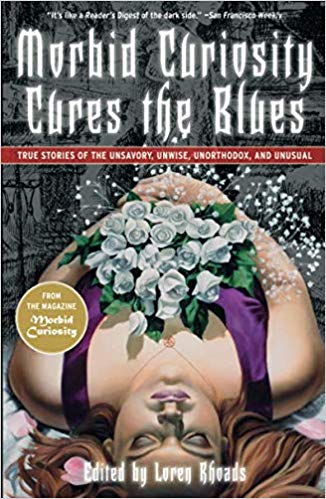 Edited By LOREN RHOADS (Scribner; 2009)
Edited By LOREN RHOADS (Scribner; 2009)
I’m not familiar with the zine MORBID CURIOSITY (1997-2006), consisting of confessions by real people about their bizarre professions, dark desires and odd experiences, but after reading this varied, unpredictable, mind-expanding assortment of 41 articles culled from the magazine, I fully understand its allure. Morbid curiosity is something we all share to some degree, regardless of whether it manifests itself in rubbernecking at the sight of car accidents, eavesdropping on private phone conversations or reading true crime paperbacks. The beauty of this book (and the magazine that fostered it) is that it allows a safe outlet for that urge. There’s much to offend in this collection, but much more to enjoy.
Freaky memoirs begin the book. M. Parfait’s “Why” relates how as a kid the author’s brother created a grid paper he wiped boogers on, leading to a most unexpected occurrence. In “The Barbie Wrecking Yard” Michael Hemmingson recalls the pervy modifications he and a girl cousin made to her Barbie dolls. Dean Estes’ “Gilding the Afterlife” details the author’s strict Mormon upbringing, while in “This is A Very Old Scar” Dorian Katz recalls being assaulted one morning and coming to with the front of her skull bashed in (we get a close-up photo of her still-nasty scar).
Part two is “Far from Home: Morbid Curiosity on the Road,” dominated by Brian Thomas’ “Souvenir of Hell.” It’s a nightmarish account of a tour Mr. Thomas took of Auschwitz, and how he allowed himself to be shut in a tiny chamber where quite a few people died during the Holocaust. There’s also “Happy Trails in Southeast Asia,” in which Jessica Eisner details the experience of imbibing a durian, a fruit whose flavor has been likened to “eating custard over a public urinal.” Daniel McQuillan frankly recounts the human rights abuses he suffered in Genoa in “Holiday in Genoa.”
“Gainful Employment” is about “The Morbid Things People do for Money.” They range from exotic dancing (in Dana Fredsti’s “Hell on Heels”) to defending a serial killer (Seth Flagsberg’s “Brain salad Surgery”) to managing a Halloween store (“Halloween Hell” by Mary Ann Stein). The most impacting of these accounts is R.N. Taylor’s “A Night in the House of Dr. Moreau,” about what happened when, working as a duct cleaner, the author stumbled into an animal testing lab. The book’s editor Loren Rhoads follows with “No Spill Blood,” about her brief employment in another such laboratory.
“Curious Behavior,” the “Morbid Catchall Category,” begins with William Selby’s “Prelude and Fugue State for Roadkill,” about a bizarre accident involving a severely maimed man and a truck full of roadkill. Mehitobel Wilson contributes a short piece about skinning a dead raccoon on Thanksgiving. Katrina James’ “Feed” describes the author’s induction into a society of vampires, and in “Be Careful What you ask For…” Vance Yount provides the requisite I-Saw-A-UFO story.
The book’s most horrific accounts (for me) are contained in the following section, “Medical Adventures: Morbid Medicine.” “Killing Max,” by “JD,” recounts a case of euthanasia (followed by a page from the California Penal Code about the legal ramifications of same). T.M. Gray’s “Slippery Little Devil” is downright skin-crawling, being perhaps the most graphic account of waking up during one’s own surgery—and the ensuing nightmares—that I’ve ever read, while Dalton Graham’s “Needles in the Spine” describes the none-too-pleasant experience of being treated for a herniated disk.
Finally there’s “Beyond Death,” dealing with the Last Exit. In “Finding Paul” George V. Neville-Neil writes of discovering the corpse of a friend who took his own life. Leilah Wendell (identified in the final pages as “America’s best-known necrophile”) contributes “Love Among the Tombs,” a passionate screed about the joys of necrophilia. In the powerful “Keeper of the Shop,” Jill Tracy writes of the death of her employer, and how he apparently sent her a missive from beyond the grave.
One last observation: the opening page of my review copy of MORBID CURIOSITY CURES THE BLUES categorizes it as “Humor.” While the book contains its share of funny elements, I definitely wouldn’t call it humorous. Frightening, grotesque and fascinating are better adjectives for a collection guaranteed to satisfy anyone’s curiosity, morbid or otherwise.
